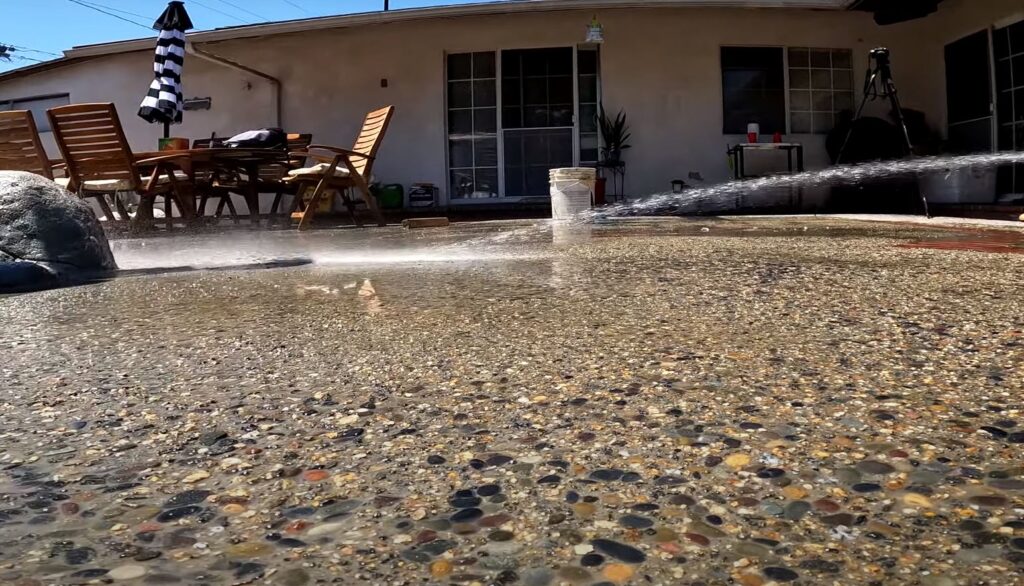
Understanding the Polished Exposed Aggregate Method
Concrete floors are taking Auckland by storm, combining both durability and aesthetic appeal. Among the numerous finishes available, polished exposed aggregate flooring stands out. But it comes with a price tag. Let’s delve into why.
Delving into the Details
The polished exposed aggregate finish exposes the underlying stones by grinding the top layer of the concrete. It’s then polished for a shimmering finish showcasing diverse stone colours and patterns.
Reasons for the higher cost include:
- Specialised Equipment: Concrete surface grinders, designed for this specific task, grind the concrete to reveal the aggregate. This intricate process requires experienced professionals.
- Multiple Steps: After grinding, the aggregate undergoes several rounds of polishing using progressively finer pads.
- Sealing: The final step is sealing the polished surface, preventing wear and stains.
- Maintenance: Despite its durability, polished exposed aggregate needs regular maintenance to retain its sheen.
Costs Across Auckland
In Auckland, floor polishing costs differ depending on location. For instance, Mission Bay, known for its classic homes, may have older floor structures than the newer residences of Henderson. This can influence the polishing techniques and, consequently, the costs.
Here’s a breakdown of polished floors prices in NZ:
- Basic Grinding & Sealing: NZD 70 per sqm
- Full Mechanical Polish: NZD 150 per sqm
- Polished Exposed Aggregate: NZD 190 per sqm
Navigating the Bylaws
In Auckland, specific bylaws dictate floor finishes, especially for heritage properties or when the process might affect neighbours. Additional consent costs combined with service charges can inflate the overall expense. Some suburbs under certain regional councils may have strict noise regulations, mandating the use of costlier, quieter machinery for floor polishing.
Making the Right Decision
Research is paramount before choosing a floor polishing contractor. Understand the method, the resulting finish, and its maintenance requirements. While polished exposed aggregate might be pricier upfront, its mesmerising finish could very well justify the expense.
| Floor Finish Type | Pros | Cons | Estimated Cost (per sqm) |
| Basic Grinding & Sealing | Durable, Quick | Less Aesthetic Appeal | NZD 70 |
| Full Mechanical Polish | High Shine, Long-lasting | Time-consuming | NZD 150 |
| Polished Exposed Aggregate | Aesthetically Superior, Unique Finish | Requires Maintenance, More Costly | NZD 190 |
Frequently Asked Questions
What is the polished exposed aggregate method?
It’s a finishing technique where the top layer of a concrete surface is ground down to reveal the aggregate stones beneath, then polished to achieve a lustrous finish.
How does polished exposed aggregate differ from regular polished concrete?
While both methods involve polishing, polished exposed aggregate reveals the underlying stones for a diverse visual appeal, whereas regular polished concrete focuses on polishing the cementitious surface.
Is the polished exposed aggregate finish durable?
Yes, it’s known for its strength and longevity, although it may require periodic maintenance to retain its sheen.
Are there any bylaws in Auckland I should be aware of when choosing a floor finish?
Certain Auckland bylaws might dictate floor finishes, especially for heritage properties or if the process may disturb neighbours. It’s advisable to consult with the local council before proceeding.
How do costs vary between Mission Bay and New Lynnfor floor polishing?
Costs can differ based on the age and type of flooring structures present. For example, older homes in Mission Bay might have different requirements compared to newer New Lynnresidences, influencing the final price.
Why does the polished exposed aggregate method cost more than other methods?
The process is more intricate, often requiring specialised equipment, multiple rounds of polishing, and specific sealants to achieve the desired finish.
Do I need to seal polished exposed aggregate floors?
Yes, sealing is a crucial final step in the process. It protects the polished surface from wear and potential staining.
How often should I maintain my polished exposed aggregate floor?
Maintenance frequency depends on foot traffic and usage. Typically, homeowners opt for a professional touch-up every few years.
Are there any health and safety concerns with floor polishing?
Dust and particles can be released during the grinding process. It’s essential that professionals use appropriate safety gear, and spaces should be well-ventilated.
How can I find a reliable floor polishing contractor in Auckland?
Research online reviews, ask for referrals, and ensure your chosen contractor is familiar with local bylaws and regulations, especially concerning specific floor finishes.
Key Takeaways
Intricacy of the Polished Exposed Aggregate Method
This method reveals the underlying stones of concrete, giving it a distinct visual appeal. The technique requires specialized equipment and multiple rounds of polishing, leading to a higher cost.
Durability and Longevity
Polished exposed aggregate is lauded for its durability. With periodic maintenance, it can retain its lustrous sheen for a long time.
Auckland Bylaws and Regulations
It’s essential to be aware of local bylaws, especially if you reside in heritage properties or if the floor polishing process might disturb neighbours. Always consult with the local council before making decisions.
Cost Variances in Different Suburbs
Factors like the age and type of flooring, and the specific requirements of certain suburbs like Torbay and Henderson, can influence the final price of floor polishing services.
Importance of Sealing
To protect and prolong the life of the polished surface, sealing is a crucial step. It guards against wear and potential staining.
Health and Safety Concerns
The grinding process can release dust and particles, making safety gear and proper ventilation indispensable.
Finding the Right Contractor
Choosing a seasoned contractor familiar with Auckland bylaws and specific floor finishes can make all the difference in achieving the desired result.
Maintenance is Key
Depending on usage and foot traffic, homeowners should opt for professional maintenance every few years to keep the polished surface in top condition.